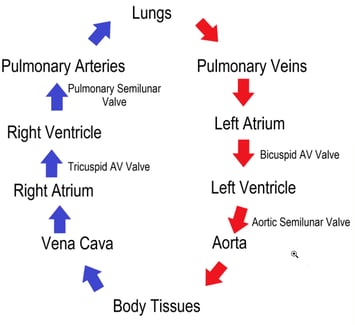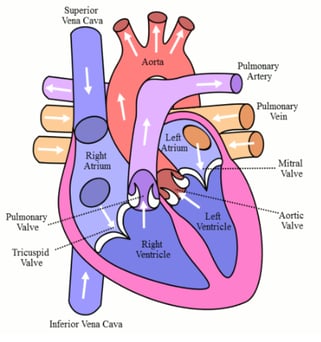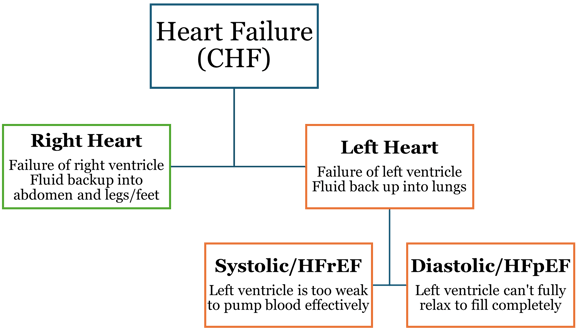
This coding tip provides an overview of coding for heart failure documented as HFpEF and HFrEF, including discussion of what these terms indicate, and the pathophysiology underlying the development of heart failure.
For an expanded education in coding heart failure, take our HIAlearn course, Congestive Heart Failure and Other Types of Heart Failure Coding.
What is Heart Failure?
Heart failure, also known as congestive heart failure, is a serious and potentially fatal condition that occurs when the heart is too weak, too damaged, or too stiff to properly fill and pump blood. Failure to pump blood effectively can lead to a buildup of fluid that can result in:
- Pleural effusion
- Swelling/edema in the legs, ankles, and feet
- Swelling in the abdomen
- Generalized weight gain from fluid retention
Other symptoms of heart failure include:
- Fatigue/weakness
- Irregular or rapid heartbeat
- Nausea or lack of appetite
- Difficulty concentrating or decreased alertness
- Chest pain
Causes and Risk Factors
As would be expected, heart conditions are most commonly the underlying cause of heart failure. There are many risk factors that lead to developing these heart conditions. The table below lists some of the common causes of heart failure and the risk factors that can lead to their development.
| Causes of Heart Failure | Risk Factors for Heart Failure |
| Coronary artery disease | Irregular heartbeat |
| Valvular disease | Uncontrolled diabetes |
| Heart attack | Uncontrolled high blood pressure |
| Cardiomyopathy | Chronic kidney disease |
| Congenital heart disease | Obesity |
| Myocarditis | Sleep apnea |
| Viral infection of the heart | |
| Use of certain medications | |
| Excessive alcohol consumption | |
| Smoking | |
| Ethnicity | |
| Aging |
How the Heart Works
To understand how the heart fails, it’s first necessary to understand how the heart is supposed to work to keep blood pumping effectively throughout the body.
Related Terms
Heart Chambers: The heart has four hollow spaces called chambers with two on the top and two on the bottom. The two at the top are called the atria and the two on the bottom are called the ventricles. There is a right and a left of each type of chamber. The heart chambers manage heartbeat and blood flow throughout the body.
Heart Valves: Heart valves are one-way valves that allow blood to flow in one direction through the chambers of the heart. The heart has four valves:
- Tricuspid – Regulates blood flow from the right atrium to the right ventricle
- Pulmonary - Regulates blood flow from the right ventricle to the pulmonary artery
- Mitral - Regulates blood flow from the left atrium to the left ventricle
- Aortic - Regulates blood flow from the left ventricle to the aorta


Illustrations courtesy of https://commons.wikimedia.org
Following the diagrams above, the path of blood flow begins when:
- Deoxygenated blood is moved from the tissues of the body, through the superior or inferior vena cava, and into the right atrium
- During the systolic (contracting/pumping) phase of the right atrium, blood is moved from the atrium through the tricuspid valve and into the right ventricle which is in its diastolic (resting/relaxing) phase.
- The right ventricle then experiences systole (contraction) and pushes the blood through the pulmonary valve and into the pulmonary arteries which take the blood to the lungs to be oxygenated.
- While the right ventricle is contracting, the right atrium is resting and filling with a new batch of deoxygenated blood.
- The oxygenated blood moves from the lungs into the pulmonary veins to fill the left atrium during its diastolic (resting/relaxing) phase. The left atrium then contracts (systolic phase) pushing the blood through the mitral/bicuspid valve into the left ventricle which is in its resting/relaxing (diastolic) phase.
- Finally, the left ventricle contracts (systole) and pushes the blood through the aortic valve and into the aorta through which the newly oxygenated blood is transported to arteries that carry it throughout the body. During the left ventricle’s contraction phase, the left atrium is resting/relaxing, allowing it to fill again with blood.
- It is important to note that both the right and left atria work simultaneously, and the right and left ventricles work simultaneously, but the atria and ventricles work opposite of each other. Thus, when the atria are in the diastolic phase the ventricles are in the systolic phase and vice versa.
Types of Heart Failure (HFrEF vs. HFpEF)
Heart failure is first divided by which side of the heart is affected, the right or the left.
- Right sided failure affects the pumping ability of the right ventricle, allowing fluid to back up and cause swelling in the abdomen and/or legs.
- Left sided failure affects the pumping ability of the left ventricle, allowing fluid to back up in the lungs and cause shortness of breath.
Left sided failure is further divided by whether the ventricle is too weak or damaged to pump blood effectively or too stiff to relax and allow for the ventricle to fill completely.
- When left sided failure is due to an inability to pump blood effectively, it is referred to as systolic heart failure (systolic phase = contraction and ejection of blood) or heart failure with reduced ejection fraction (HFrEF) because the heart had a decreased ability to eject (pump) blood from the ventricle.
- When left sided failure is due to an inability of the ventricle to fill completely, it is referred to as diastolic heart failure (diastolic phase = relaxation and filling with blood) or heart failure with preserved ejection fraction (HFpEF) because the heart still has the ability to eject (pump) blood from the ventricle, it just doesn’t eject the optimal amount.

Heart failure with reduced ejection fraction (HFrEF) = Systolic heart failure
Heart failure with preserved ejection fraction (HFpEF) = Diastolic heart failure
Coding Heart Failure Documented as HFpEF or HFrEF
ICD-10-CM classifies left heart failure by type; systolic, diastolic, combined systolic and diastolic or unspecified and by acuity; acute or chronic. There are no entries in the Index to Diseases for HFrEF or HFpEF, but providers often use these terms rather than, or in addition to, the terms systolic/diastolic to document a patient’s condition.
In 2016 Coding Clinic stated that is it acceptable for coders to interpret documentation of HFrEF as systolic heart failure and documentation of HFpEF as diastolic heart failure. Coders may also use the following or similar language as the basis for coding heart failure as systolic or diastolic:
- Heart failure with preserved diastolic function
- Heart failure with low ejection fraction
- Heart failure with reduced systolic function
Additional Coding Clinics have been released that address how the use of other terminology related to heart failure should be coded.
- Heart failure described as mid-range or mildly reduced ejection fraction (HFmrEF) is coded as chronic systolic heart failure
- Heart failure described as with recovered (HFrecEF) or improved ejection fraction (HFimpEF) is coded as chronic diastolic heart failure.
Take Aways
Heart failure can be divided into two types; right and left. Left heart failure is further divided into two sub-types: systolic and diastolic.
- Systolic failure represents an inability of the left ventricle to contract efficiently enough to eject blood effectively. This is referred to as heart failure with reduced ejection fraction (HErEF).
- Diastolic failure represents the left ventricle’s inability to relax enough to fill with blood completely even though it retains the ability to contract and eject blood efficiently. This is referred to as heart failure with preserved ejection fraction (HFpEF).
Coding clinic advises that it is allowable for the coder to select heart failure codes specified as systolic or diastolic based on documentation of heart failure as HFrEF or HFpEF or in similar terms as presented above.
References
- AHA Coding Clinic, Third Quarter 2023: Page 14
- AHA Coding Clinic, Third Quarter 2020: Page 32
- AHA Coding Clinic, First Quarter 2016: Page 10
Since 1992, HIA has been the leading provider of compliance audits, coding support services and clinical documentation audit services for hospitals, ambulatory surgery centers, physician groups and other healthcare entities. HIA offers PRN support as well as total outsource support.
The information contained in this coding advice is valid at the time of posting. Viewers are encouraged to research subsequent official guidance in the areas associated with the topic as they can change rapidly.
Subscribe to our Newsletter
Recent Blogs
Related blogs from Industry News , Medical Coding Tips
Interventions for endovascular revascularizat...
The 2026 updates to CPT and the Hospital Outp...
Accurate diagnosis coding relies on recognizi...
Halloween brings fun, fright—and a rise in em...
Subscribe
to our Newsletter
Weekly medical coding tips and coding education delivered directly to your inbox.


.png)


